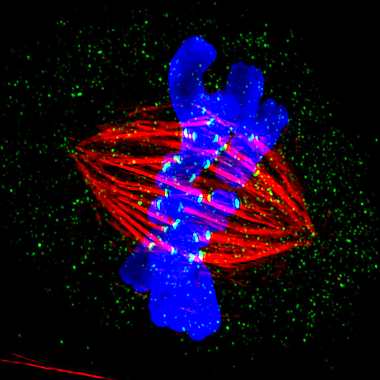
A metaphase epithelial cell stained for microtubules (red), kinetochores (green) and DNA (blue), was the winning image, taken by Indiana University researcher Jane Stout
Brought to you by WBIW News and Network Indiana
Last updated on Friday, March 8, 2013
(BLOOMINGTON) - The image captured by Indiana University researcher Jane Stout is so dazzling it won an international competition and will be displayed on an electronic billboard in Times Square.
Mike Leonard of the Herald-Times reports that it's such a beautiful example of the extraordinary complexity of not just life but the micro components of living organisms that it will be replicated on canvas for viewing at the Academy of Medical Sciences in London.
Stout and fellow researcher Claire Walczak had reason to smile last week when word came that Stout's spectacular image of an intricacy of basic cell division won the high- and super-resolution microscopy category of the GE Healthcare Life Sciences 2012 Cell Imaging Competition.
But it was the sizzle behind the sizzle that had the biologists buzzing in Walczak's laboratory in Myers Hall last week. Thanks to IU's investment in its Light Microscopy Imaging Center, the support of the National Institutes of Health, and $1.2 million from the American Recovery and Reinvestment Act of 2009 -- best known as the federal stimulus initiative -- the benefit of pure science was on full display.
The award-winning high-tech image was created through research into basic biology.
"Funding for science is already terrible, and if these cuts they're talking about (through federal sequestration) go through, they'll have a devastating downstream consequence," said Walczak, a professor of biochemistry and molecular biology in the Medical Sciences Program, a branch of the IU School of Medicine. "We're mainly basic scientists here, trying to understand how things work."
While there's a lot of discussion these days -- for good reasons -- about interdisciplinary and multi-disciplinary work in academia, work by researchers such as Walczak and Stout drills deeper and deeper into their particular silo -- probing further and further into the basic microbiology.
Walczak's lab includes research into a specific family of proteins involved in attaching and moving DNA along a subcellular structure called a spindle that separates chromosomes during cell division.
"With the equipment we have here at the light microscopy center, we're seeing things we've never been able to see," said Walczak, who also is executive director of the center.
"We're able to isolate things and analyze things at a level never possible before," agreed Stout. The potential benefits multiply forward into any number of other areas of directed research in science, medicine and pharmacology.
In normal cell division that takes place throughout life, cells that don't function properly typically die, with no discernible consequence. In cancer, however, they multiply, for reasons mostly still unknown to science. "If you don't understand what happens when something works correctly, you don't understand what went wrong later," Stout said.
While the researchers probe pure science and pure biology, the consequences of cancer are never far from their minds. "One in four people die of cancer," Stout said. "And then, add to that the number of people who get cancer and don't die from it. It's really incredible to consider."
It's clear that the work being done in microbiology and light microscopy at IU is helping researchers in various areas of study. About 150 users from 50 laboratories across campus are making use of the Light Microscopy Center. That work helps to support grants worth more than $10 million that come into the campus.
And while that's what gets Walczak and Stout most excited, the "eye candy" image -- a term technical director Sid Shaw likes to use -- and the GE award are still appreciated.
"We don't get many pats on the back in science," Stout said.
"A lot of our lives are about rejection and failure these days," Walczak added.
The award provides for two people to fly to New York City to be honored and witness the image displayed on NBC Universal's HD screen in Times Square in April. Under normal circumstances, that would be Stout, the official award-winner, and Walczak, in whose lab she works.
"I'll by flying over New York right about the time this happens," Walczak said, rolling her eyes. "I made a commitment to be in London, and even though I knew we'd entered this competition, you sure couldn't plan your life thinking you'd win."
Walczak pressed her research associate to enter the contest. And Stout said she got her entry in literally minutes before the deadline. "It called for three entries, and I picked two and asked Claire if she had any suggestions," Stout said with a smile. "She picked the one that won."

A metaphase epithelial cell stained for microtubules (red), kinetochores (green) and DNA (blue), was the winning image, taken by Indiana University researcher Jane Stout
1340 AM WBIW welcomes comments and suggestions by calling 812.277.1340 during normal business hours or by email at comments@wbiw.com
© Ad-Venture Media, Inc. All Rights Reserved.